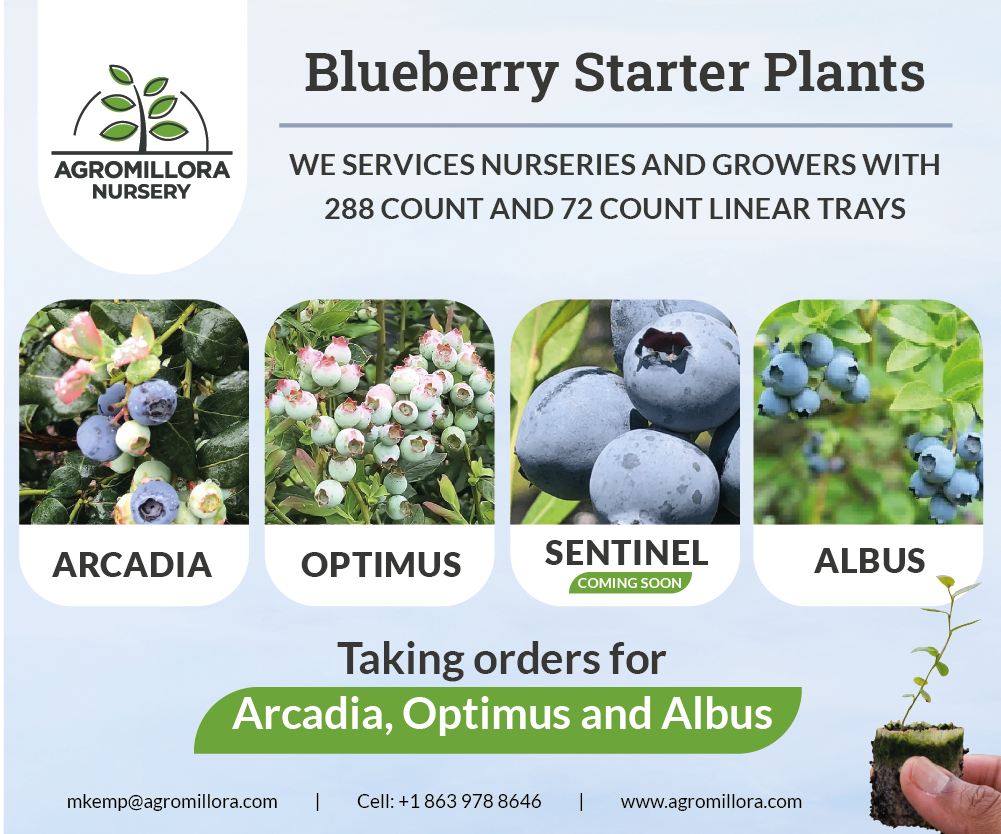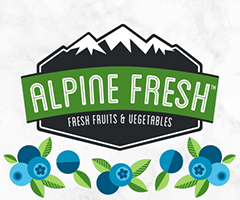Update on Use and Ongoing HC Research in Florida Blueberries
by JEFF WILLIAMSON, JACOB BUCK, and GERARDO NUNEZ, IFAS, University of Florida
Winter and spring weather is increasingly unpredictable. In years when chilling requirements are not met, certain southern highbush blueberry (SHB) cultivars exhibit slow or delayed leaf growth under the deciduous production system. Delayed leaf canopy development can result in slower fruit ripening, reduced fruit quality, and plant stress, especially for plants that set a moderate to heavy crop. Hydrogen cyanamide (HC), trade names Dormex and BudPro, is a plant growth regulator that may be a useful tool for stimulating early and abundant spring leafing of certain SHB cultivars. For cultivars that respond favorably to HC, the harvest season is often earlier and more concentrated than would otherwise occur. Increased berry weight (size) and a slight increase in total yield have also been reported in some cases, but the main advantages are crop earliness and concentration of harvest.
Hydrogen cyanamide is classified as a restricted-use pesticide with specific requirements for its safe and legal application. These include specialized protective gear, loading, and spraying equipment (e.g., an enclosed tractor cab). Growers who are interested in using HC but lack the specialized equipment, license, or expertise for its safe and legal application, may want to consider custom application services.
Not all blueberry cultivars grown in Florida need or respond well to HC treatment. In fact, some cultivars are susceptible to injury (spray burn) from HC. HC responses are cultivar-specific, but plant and environmental conditions prior to, during, and immediately after HC applications are believed to also affect the responses. Obviously, many variables come into play for a successful HC response. Dormancy, chill accumulation, and the timing of natural bud break should be carefully monitored in blueberry fields to be treated with HC. Prior to treatment, plants should be completely dormant and have received some natural chilling. At this time, the optimum chilling threshold is not known, but generally under Florida conditions, the more chilling that occurs prior to treatment, the better the response.
HC should be applied before a significant percentage of the flower buds have grown past developmental stage 2 (Figures 2 and 3). Flower buds that are past stage 2 are more susceptible to HC injury than less advanced flower buds. Product labels state that applications should be made 30 or more days prior to natural bud break. In Alachua County, the combination of pre-chilling and bud break events usually puts HC applications between mid-December and early January. Decisions regarding whether or not to use HC, and the timing of HC applications, should be based on cultivar tolerance, potential risk/benefit, plant condition (dormancy, prechilling, and flower bud stage), weather, and anticipated date of natural bud break.
In years or locations where blueberry plants do not achieve full dormancy and/or are not exposed to adequate prechilling prior to HC application, significant stem and flower bud injury and crop loss may occur, even on otherwise HC-tolerant cultivars. HC injury is generally a greater problem in the warmer production areas of Florida where chilling is limited and complete dormancy may not be attained during some winters. Since chilling requirements are difficult to satisfy in the southern production regions of the state, growers in these areas of Florida often use the evergreen production system which avoids dormancy and neither requires nor is compatible with HC use. More information on the evergreen production system can be found at https://edis.ifas.ufl.edu/pdffiles/HS/HS136200.pdf
Cultivars commonly grown in Florida range from HC-tolerant to very HC-sensitive (susceptible to injury). When the tolerance to HC is not known, HC applications should be tested in small groups of plants prior to large-scale use. Ongoing research evaluating the response of two recent releases from the UF Blueberry Breeding Program (cultivars ‘Optimus’ and ‘Colossus’) to HC treatment is described below.
Mature plants of “Optimus” and “Colossus” were evaluated in Straughn Farms in Waldo, Florida during 2019 and 2020. “Optimus” was treated with 0.75 %, 1.0 %, or 1.25 % Dormex. “Colossus” received the same treatments, but with the addition of 1.5 % Dormex. For both cultivars, a treatment without HC served as the control. Cultivars were monitored from January 18 to February 27 in 2019, and January 8, 2020 to March 28, 2020. Both cultivars exhibited earlier and increased vegetative bud break and leaf canopy development compared to the controls. HC-treated “Colossus” plants exhibited earlier and more uniform flower budbreak, but HC-treated “Optimus” exhibited delayed flower budbreak. During the 2019 season, there were no consistent differences among treatments for time of harvest of “Colossus.” However, “Colossus” harvest was complete for all treatments early in the season (April 23). “Optimus” harvest was only advanced by the 1.25% rate at one harvest date (April 11) during 2019. Although reproductive buds had a higher mortality rate with increasing HC treatments, the end-of-season cumulative yield was not affected by HC treatment for either cultivar in 2019. Unfortunately, COVID-19 restrictions prevented us from collecting yield data in 2020. Thus, the results presented above represent only one season and are not sufficiently thorough for developing application recommendations. Our goal is to continue this work, along with other experiments, to develop HC recommendations for these SHB cultivars.
During fall 2020, we will explore the effects of HC application timing on “Optimus” plants. We will use a growth chamber to force container-grown plants to produce flower buds and enter dormancy. Plants will be exposed to short days (8 hours light and 16 hours dark) using LED light fixtures. Once plants are dormant, they will be exposed to 0 (control), 50, 100, 150, or 200 hours of artificial chilling at 7° C. Since “Optimus” is sensitive to HC, a moderate treatment rate of 1% Dormex will be applied to each group of plants. Data for vegetative and reproductive bud development, vegetative bud concentration, reproductive bud mortality rate, and yield will be collected for each treatment. Cane samples will be collected for carbohydrate analysis. Together, these data may help explain why blueberries respond differently, and sometimes unpredictably, to HC treatment.
HC can be a useful tool for growers using the deciduous system, but decisions on HC application rates and timing are complex and case-specific. More information on use of HC in Florida blueberries can be found at https://edis.ifas.ufl.edu/pdffiles/HS/HS22000.pdf and https://edis.ifas.ufl.edu/pdffiles/HS/HS38000.pdf.
Always read the product label carefully and follow label instructions.
Figure 1. Blueberry flower bud development stage 2. The buds are swollen but bud scales remain closed. Photo credit: Jeff Williamson.
Figure 2. Blueberry flower bud development stage 3. The bud scales are beginning to separate. This stage, and more advanced developmental stages, are generally more susceptible to injury from HC sprays than stage 2. Photo credit: Jeff Williamson.






